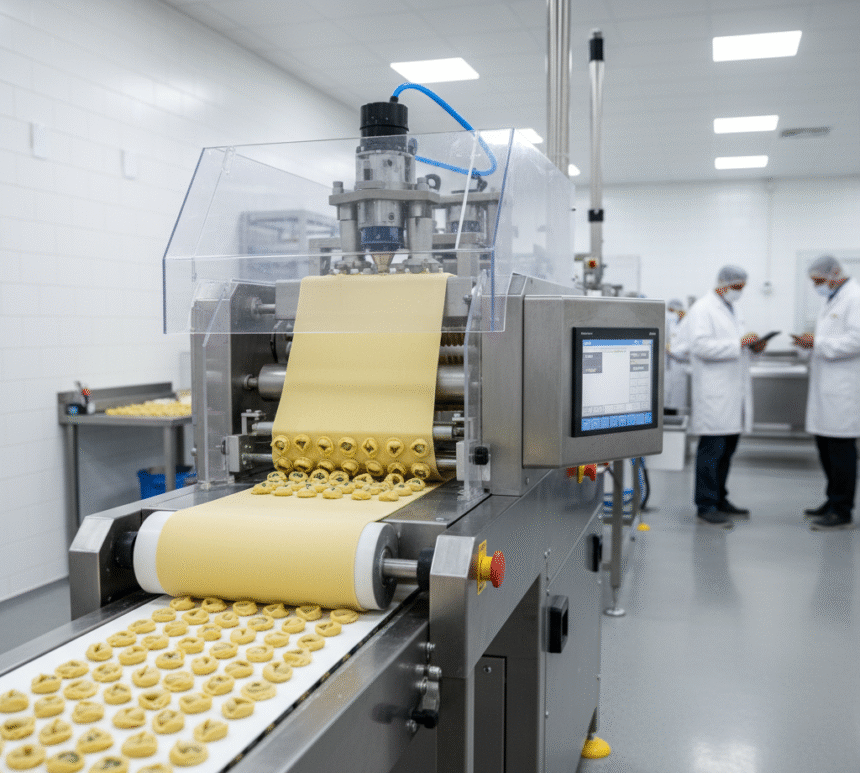What Is a Tortellinatrice?
If you’ve ever admired the delicate folds of a perfect tortellini and wondered how producers manage to create thousands of them every day with the same precision, the answer lies in a remarkable piece of equipment called the tortellinatrice. This specialized machine is designed to automate the process of shaping and sealing tortellini — one of Italy’s most beloved stuffed pastas.
While the craft of hand-making tortellini remains a proud culinary tradition, the tortellinatrice brings consistency, speed, and efficiency to professional kitchens and pasta factories. It replicates the artisan’s touch, ensuring every piece has the right thickness, filling distribution, and closure — without compromising quality. In short, it’s a bridge between craftsmanship and modern production.
How a Tortellinatrice Works
A tortellinatrice may look complex, but its operation follows a clear and elegant logic. The machine typically combines several mechanical and pneumatic systems to perform multiple tasks in one continuous motion:
| Process Step | Function | Description |
| Sheet Feeding | Dough preparation | A smooth sheet of pasta dough is rolled to a precise thickness and automatically fed into the machine. |
| Filling Injection | Filling placement | The machine injects the desired amount of filling (such as meat, cheese, or spinach mixtures) onto the dough sheet at regular intervals. |
| Folding and Sealing | Shape formation | Mechanical arms or rollers fold the dough over the filling, cut each portion, and seal the edges tightly. |
| Molding | Final shaping | The tortellini are shaped into their characteristic ring form, ready for cooking or packaging. |
Modern models can produce thousands of tortellini per hour while maintaining uniformity in shape and size. Some machines are fully automated, while others allow partial manual control for small-scale or artisanal production.
Key Features That Define a Quality Tortellinatrice
Not all tortellinatrici are created equal. Professional pasta makers look for certain features that influence the final product’s quality and the machine’s reliability.
- Adjustable Dough Thickness:
Different fillings and pasta types require variations in dough thickness. High-end machines allow precise adjustments to ensure the perfect texture — soft enough to fold easily, yet firm enough to hold the filling. - Customizable Filling System:
The filling consistency can vary from creamy ricotta blends to coarser meat mixtures. A good tortellinatrice handles this diversity with interchangeable nozzles or variable pressure systems that keep the filling even. - Easy Cleaning and Maintenance:
Food production demands strict hygiene. Machines with detachable components and stainless steel construction make cleaning faster and safer, reducing downtime between batches. - User-Friendly Interface:
Modern tortellini often include digital control panels. Operators can set parameters such as speed, filling volume, and production count, simplifying the process even for less experienced staff.
Benefits of Using a Tortellinatrice in Professional Kitchens
Whether in a restaurant, pasta laboratory, or industrial facility, the tortellinatrice offers several advantages that go beyond mere convenience.
- Consistency and Quality Control
Every tortellino must look and taste the same, especially for brands that sell packaged pasta. A tortellinatrice ensures identical results, reducing variations caused by human fatigue or error. The precision also enhances cooking performance — uniform pieces cook evenly, preserving flavor and texture. - Time and Labor Efficiency
Making tortellini by hand is labor-intensive and time-consuming. With a tortellinatrice, production time is drastically reduced. Staff can focus on creative tasks, like developing new fillings or sauces, rather than repetitive shaping. - Reduced Waste
Because the machine cuts and folds dough with precision, it minimizes offcuts and ensures every gram of dough and filling is used effectively. This not only saves ingredients but also improves cost efficiency — a major plus for high-volume producers.
Different Types of Tortellinatrici
The right tortellinatrice depends on the scale and goals of the production. Generally, these machines fall into three main categories:
| Type | Ideal For | Production Capacity | Typical Features |
| Manual or Semi-Automatic | Small restaurants, artisan pasta shops | Low to medium | Operator-assisted feeding and shaping; ideal for short runs. |
| Automatic | Medium to large pasta producers | Medium to high | Fully automated folding, sealing, and cutting; consistent output. |
| Industrial | Factories and large-scale distributors | Very high | High-speed production lines with continuous feed systems and advanced quality control sensors. |
Semi-automatic models allow for a more artisanal feel — often chosen by gourmet pasta brands that want to retain a handmade aesthetic while improving efficiency. Industrial models, on the other hand, are engineered for 24/7 operation and can produce different pasta shapes using interchangeable molds.
Materials and Build Quality
The durability and hygiene of a tortellinatrice depend heavily on the materials used in its construction. Most professional models are made of food-grade stainless steel, which resists corrosion and complies with international food safety standards.
Some parts — such as rollers, molds, and filling injectors — are removable for easier cleaning and maintenance. High-quality machines also feature anti-stick coatings on dough-contact surfaces, preventing tears or clogging during continuous operation.
Manufacturers often design their machines with ergonomic considerations in mind, ensuring operators can easily access key components without strain. These small design choices contribute significantly to long-term performance and user safety.
How to Choose the Right Tortellinatrice for Your Needs
Selecting the ideal tortellinatrice depends on several factors — from production goals to available space and budget. A thoughtful purchase ensures that the machine not only meets your immediate requirements but also supports long-term growth.
- Define Your Production Scale
Before anything else, determine how much pasta you intend to produce daily. A small trattoria might benefit from a compact semi-automatic model, while a pasta factory requires a robust industrial line that can handle continuous operation. - Assess the Type of Filling and Dough
Not all machines perform equally with different dough and filling textures. For example, a machine designed for smooth cheese fillings might struggle with chunkier meat blends. Always test a sample or consult with the manufacturer about the machine’s compatibility with your recipes. - Check for Customization Options
Some models allow for interchangeable molds or accessories to produce different pasta shapes like ravioli or cappelletti. If your menu changes seasonally, investing in a versatile unit can save money and space over time. - Evaluate After-Sales Support and Spare Parts
Reliable technical support is essential. Choose brands with a strong service network and readily available replacement parts. Downtime due to maintenance delays can quickly become costly in a production environment.
Maintenance and Care: Extending the Life of Your Tortellinatrice
Like any precision machine, a tortellinatrice requires regular maintenance to operate smoothly and safely. Routine care not only prevents breakdowns but also ensures consistent pasta quality.
Daily Cleaning
After each production cycle, all parts that come into contact with dough or filling should be cleaned thoroughly. Many modern machines feature detachable components for easy washing. Use warm water and mild detergents — harsh chemicals can damage metal surfaces and seals.
Lubrication and Inspection
Mechanical parts like rollers and gears need proper lubrication to minimize friction. Inspect belts, bearings, and seals regularly to catch early signs of wear. Keeping a simple maintenance log helps operators track performance and plan timely servicing.
Electrical and Safety Checks
Ensure all electrical connections are secure and that safety guards are functioning correctly. Industrial-grade machines often come with automatic shut-off features that prevent accidents — test these periodically to ensure reliability.
| Maintenance Task | Frequency | Purpose |
| Cleaning removable parts | After every use | Prevent dough residue buildup |
| Lubricating moving components | Weekly | Reduce wear and tear |
| Checking seals and belts | Monthly | Maintain tight closure and smooth operation |
| Electrical inspection | Quarterly | Ensure safety and efficiency |
Consistent care can extend the lifespan of a tortellinatrice by several years, protecting your investment and maintaining production quality.
Leading Brands and Innovations in Tortellinatrice Design
The market for pasta-making equipment has evolved significantly, with Italian manufacturers continuing to lead the field. Some of the most respected brands include Imperia, Pama Roma, Bottene, and La Monferrina — each known for combining traditional craftsmanship with cutting-edge automation.
Modern tortellinatrici integrate digital controls, programmable settings, and precision sensors that adjust filling dosage and dough tension automatically. Some even connect to centralized monitoring systems, allowing factory operators to oversee production in real time and make adjustments remotely.
Sustainability is another growing focus. Many brands are developing energy-efficient motors and waste-reducing systems, aligning with the food industry’s shift toward greener manufacturing. These innovations not only improve operational efficiency but also enhance a company’s environmental profile.
Common Mistakes to Avoid When Operating a Tortellinatrice
Even the best equipment can’t compensate for improper use. Avoiding these frequent mistakes will help ensure steady production and consistent quality:
- Skipping Calibration: Always check dough thickness and filling levels before a production run. Even slight variations can affect texture and sealing.
- Neglecting Temperature Control: Dough that’s too cold or too warm may stick or tear during folding. Keep ingredients at stable, room-temperature conditions.
- Overfilling the Machine: Excess filling can cause leaks and deform the tortellini shape. Follow manufacturer guidelines for capacity limits.
- Ignoring Routine Cleaning: Residue buildup can lead to contamination or machine jams. A few minutes of cleaning after use prevents bigger problems later.
A disciplined approach to operation ensures that your tortellinatrice runs efficiently for years while consistently producing perfect pasta.
The Value of a Tortellinatrice in Today’s Culinary Industry
In an era when efficiency and authenticity both matter, the tortellinatrice stands out as a crucial tool for pasta professionals. It allows producers to maintain traditional flavors while meeting modern demands for volume, precision, and hygiene.
Restaurants benefit from faster turnaround times and consistent quality, while large-scale manufacturers enjoy higher productivity and lower waste. For consumers, it means enjoying tortellini that taste just as authentic as those crafted by hand.
More than a machine, the tortellinatrice represents the ongoing evolution of Italian pasta-making — where tradition and innovation work hand in hand.
Conclusion: Tradition Perfected Through Technology
The tortellinatrice proves that technology can honor tradition rather than replace it. By streamlining the intricate process of forming tortellini it allows chefs and producers to focus on creativity and flavor, not repetitive labor.
Whether you’re running a boutique pasta lab or managing an industrial production line, investing in a reliable tortellinatrice means ensuring quality, efficiency, and authenticity with every batch. It’s a testament to how craftsmanship and modern engineering can come together — preserving the heart of Italian cuisine while embracing the future of food production.
For more quality, informative content, visit writewhiz







